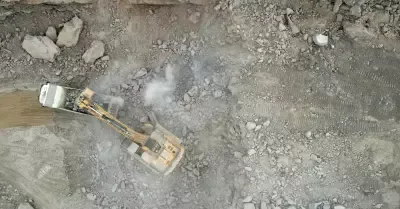
Under a cloud of gray dust, an excavator loads a truck with stone blocks containing lithiumthe mineral called “white gold” essential for the energy transition.
The movement of heavy machinery is incessant on the reddish earth, in the heart of the Jequitinhonha valley, in the state of Minas Gerais (southeast), one of the poorest regions of Brazil.
Long called the ‘”Valley of Misery”, This semi-arid region, home to close to a million people, is currently seen as a new El Dorado – the ancient legend of the city made of gold and lost in South American lands. This is thanks to the abundance of lithium, the mineral used to manufacture batteries for electric cars and cell phones, among others.
About 85% of the reserves of Brazil, the world’s fifth largest lithium producer, are in this region.
To attract foreign investors, last month local authorities launched with great fanfare the concept of Lithium Valley (“Valley of Lithium”), at the headquarters of the Nasdaq, the new technologies exchange in New York.
“Green lithium”
A Canadian company, Sigma Lithium, took the lead. Founded in 2012, the group began mining lithium in the Jequitinhonha valley last April.
Its goal is to supply enough mineral for the batteries of more than 600,000 electric vehicles in the first year and triple when production reaches its normal rate.
But the exploitation of lithium is not without environmental impacts: the treatment of the mineral requires enormous amounts of water, while the reserves are found mainly in regions hit by drought.
However, the Canadian company declares itself a producer of “green lithium”: In the mineral treatment plant, 90% of the water is subsequently reused and no chemical products are used, points out Ana Cabral-Gardner, Sigma’s Brazilian director.
“We seek to solve the equation between mining activity and sustainable development”, Explain.
The turning point, he says, occurred in 2015, when a dam burst at an iron ore mine in Mariana, some 400km south of the Jequitinhonha Valley, an unprecedented environmental catastrophe in Brazil. The following year, his investment fund became Sigma’s first shareholder.
Cabral-Gardner details that the company’s mine, baptized “Grotto of Cirilo”is divided in two to preserve a small watercourse that runs through it, despite the fact that this represents a significant economic loss.
“The walls are shaking”
But the idea of transforming the region into the “Valley of Lithium” it also has its detractors.
“This is the Jequitinhonha Valley, they want to place a mineral above our identity”firmly maintains Aline Gomes Vilas, 45, a member of the Movement of People Affected by Dams (MAB) in Brazil, which estimates that the local inhabitants were not sufficiently consulted about the works.
Gomes lives in Araçuaí, one of the neighboring cities of the Sigma mine. “It used to be a quiet, rural region, and now the noise is constant. There are already cracked houses due to the explosions” made on the rocks, he says.
The stones ejected in the explosions are collected by large excavators and trucked in to be processed at the plant.
“With every explosion, the walls shake”agrees Luiz Gonzaga, a 71-year-old resident who lives right next to the mine.
“For now, they are still digging far from my house, but the dust bothers me. Imagine when they are closer ”, emphasizes.
Ilan Zugman, director of the NGO 350.org for Latin America calls for greater attention to local people.
“This region already had a gold and diamond rush, but those extractions never brought development (…) There must be an energy transition, but it has to be fair and inclusive”it states.
less restrictions
Elaine Santos, a researcher at the University of Sao Paulo, also criticizes that the lithium extracted in Brazil is destined almost exclusively for export, “while the United States and Europe develop strategies taking into account the entire production chain, from the mine to the production of vehicles” electrical.
“Brazil may end up deepening its dependency, being a country that only exports raw materials, with low added value”the Mint.
Lithium extraction in the country dates back to the 1920s, but the situation changed after a decree in July 2022, in the last year of the term of far-right former president Jair Bolsonaro (2019-2022). The text made the market more attractive to foreign investors, especially by lifting restrictions on mineral exports.
But an envoy from the government of his successor, the leftist Luiz Inacio Lula da Silva – who is holding the presidency for the third time – was also present in New York to actively promote the launch of the campaign to promote the “Valley of Lithium”.
In contrast, in Chile, the world’s second largest producer of the mineral, his counterpart Gabriel Boric, also on the left, recently announced measures to strengthen state control over lithium extraction.
Source: AFP
Source: Gestion
Ricardo is a renowned author and journalist, known for his exceptional writing on top-news stories. He currently works as a writer at the 247 News Agency, where he is known for his ability to deliver breaking news and insightful analysis on the most pressing issues of the day.











